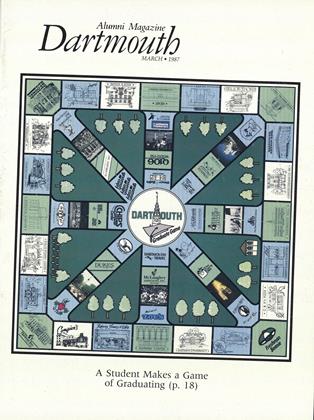Making Tracks
After a decade in a warmer climate, I met the snow forcefully this past January. That was when I first noticed a subtle change in the nature of cross-country trails that appears to be affecting the entire north country.
Just as winter began, my daily office commute switched from an hour on the Washi ngton Beltway to an hour on the machinegroomed cross-country ski trails of the Hanover Country Club _ counting time spent on irresistible detours. It didn't take me long to get acclimated; my daily route now goes through a spectacular new 30-kilometer trail complex maintained by the College.
A week or so into the new year, a foot of snow fell onto a half-foot base, and on Sunday we awoke to the season's best skiing. "Sorry," I told my wife, "I've got to put in a few hours at the office. It's the nature of a new job." And, with a small twinge of guilt, I donned Nordic skis and headed from our apartment on Reservoir Road down to the Connecticut River the most roundabout way possible to ski to campus.
Halfway to the river I saw the change that had come over the snow: the trail hooked up with a wide path, and the parallel tracks disappeared in an anarchistic jumble of slash marks and pole holes. This disturbed me greatly, because I had come to find satisfaction in a well-tracked Nordic trail that cuts through field and woods in what Frost would call "a momentary stay of confusion." One's skis faithfully follow the tracks, with only an occasional interruption for a steep hill. I write as an expert on snow, owing to my status as an inept skier. A skier who falls frequently, and keeps an open mind while doing it, learns things about the snow that the expert has forgotten. A good skier rarely feels the soft nihilism of a fresh snowbank, or the no-nonsense abrasion of an iced-up trail. On the other hand, a properly inept skier one who meets the snow head-on, opening his mouth in surprise as he falls is much more discerning about the stuff he lands in; he becomes something of a snow gourmet.
While quietly congratulating myself on my lack of prowess, I caught the edge of my ski on a herringbone and suddenly tasted snow (dry texture, good loft, and a piquant bouquet that hinted of road salt). Pulling my head out of the snowbank, I was startled to see heading toward me a phalanx of brightly clad skiers. Obviously competing in a race, they were propelling themselves with a strange, limping style that emphasized poles and hips.
I had seen the technique; called skating, for years. In the old days, skiers did it when there were no tracks, and they were on a flat surface, and they wanted to look snappy. But most of the time, one skied by throwing one's shoulder forward and hoping that the rest of the body followed before the opposite ski skidded backward. Done properly, the old technique looked like an exaggerated form of running.
The amazing thing about these fast-approaching skiers was that they were skatinguphill not just herringboning or running with quick little steps, but gliding as if gravity were nothing but a fading tradition. I was forced to roll back into the snowbank to avoid a collision. The competitors scuttled up the incline like deft crabs, sashaying their hips in second-skin space fabrics.
I took mental notes as the skiers whizzed by, and then triec} the technique on skis that suddenly seemed impossibly long. As far as I can tell, the trick of skating uphill requires performing the following steps all at the same time: plant one ski at a 165-degree angle, tip facing outward. Also plant both poles while lifting the unplanted ski in a careless gesture. Using all your strength, shove with the poles and the planted ski. Do all of this unconsciously, but take care that your poles are outside your skis or you will find yourself face-down on the trail (sticky texture, with a faint ripple of blue wax).
Those who fail to make the transition to skating risk showing their age. Good young skiers skate; good old skiers throw their shoulders forward in a fit of obsolescence. The College does oblige the obsolete skier by diligently replacing skatec}-on trails with clean, fresh tracks. But they are all too quickly erased by the new skiers. There is nothing for it but to adapt, and risk a violent intimacy with the snow (faint smell of pine, texture of snowplow effluvia . . .).
Jay Heinrichs became editor of this magazine lastDecember.
 View Full Issue
View Full Issue
More From This Issue
-
 Feature
Feature"These Children Are the Future"
March 1987 By Shelby Grantham -
 Cover Story
Cover StoryPassing With A Roll Of The Dice
March 1987 By Jay Heinrichs -
 Feature
FeatureThe Magic Bullet
March 1987 By B.J. Schulz arid Mary McFadden -
 Feature
FeatureOne Question for Mr. Frost
March 1987 By Philip Booth '47 -
 Article
ArticleDartmouth Authors
March 1987 -
 Class Notes
Class Notes1983
March 1987 By Ken Johnson
Jay Heinrichs
-
 Cover Story
Cover StoryThe Scholar President
June 1987 By Jay Heinrichs -
 Article
ArticleOut of the Woods
NOVEMBER 1988 By Jay Heinrichs -
 Feature
FeatureBob Pack's Quantum Cat
December 1989 By Jay Heinrichs -
 Feature
FeatureELECTRIC BODY LANGUAGE
SEPTEMBER 1991 By JAY HEINRICHS -
 Article
ArticleYour Breath Smells So Bad People on the Phone Hang Up.
November 1994 By Jay Heinrichs -
 Outside
OutsideRunning With Wild Abandon
July/Aug 2002 By Jay Heinrichs







